Are you embarking on a journey to Kimolos Island? This guide is your essential companion, offering not just travel advice but a vivid glimpse into this small island’s charm.
Here, white sand beaches blend seamlessly with crystal clear waters, inviting you to unwind at a cozy beach bar or embark on an exhilarating boat trip.
Our travel guide reveals the best things to do on Kimolos Island, from exploring unique rock formations to savoring the island’s beauty in the summer months. This beautiful island is more than a destination; it’s an experience.
Dive into our guide for a blend of practical tips and engaging insights, making your trip to Kimolos Island unforgettable.
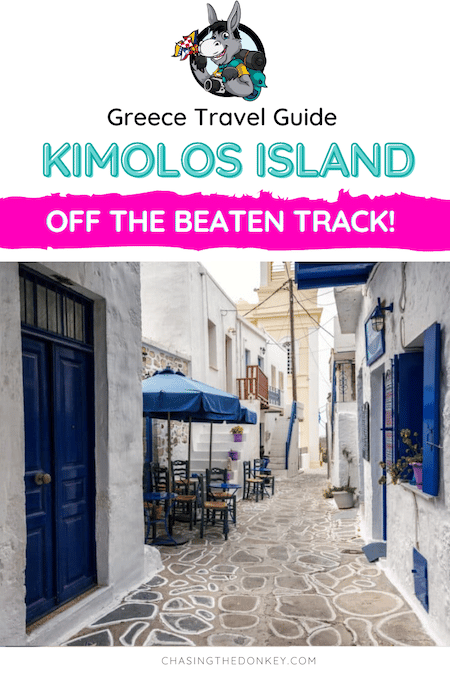
Pretty unknown and off-the-beaten-track, Kimolos is a beautiful Greek island with just under a thousand permanent inhabitants, gorgeous beaches, and plenty of opportunities for outdoor experiences.
If you’re considering a different destination in Greece, this guide will tell you about the best things to do in Kimolos.
Skip Ahead To My Advice Here!
General Information About Kimolos
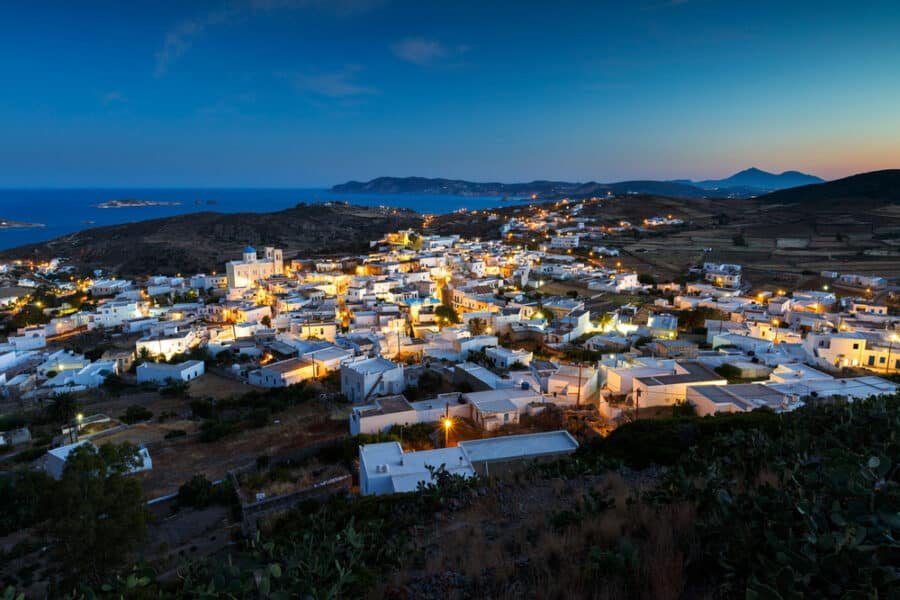
Kimolos is a small and peaceful Greek island located in the Aegean Sea. The island has a rugged, rocky terrain, with cliffs and steep slopes rising from the sea, amazing whitewashed houses, cobble-stoned alleys with typical Greek churches, and a charming atmosphere. The island’s shores are full of small, pebble beaches, where the waves of the Aegean Sea gently splash against the coast. When wandering up and down the strand, you can hear seagulls singing their merriest songs as they soar overhead. The island has a population of about 1,000, making it the best place for a relaxing holiday and getting away from the crowds.
Although the island has a relatively small population, its history is rather rich compared to other islands in the Cyclades. The island has been an important trade hub since antiquity. Ancient Athens, Spartans, and other Greek nations of antiquity used to fight over the island of Kimolos. In the Middle Ages and during Ottoman rule, the island preserved its significance as a trade hub for the Mediterranean. However, today, the island’s economy depends on tourism, and its population continuously decreases.
Kimolos is often a fantastic destination for a day trip from other islands; however, not many tourists consider Kimolos as a final destination for their vacation. And they are missing quite a lot… First and foremost, by overlooking a stay in Kimolos, they miss the chance to experience living on an unspoiled island that has kept many traditions alive. With an economy based on land-related activities, including farming and mining, life on Kimolos is slow-paced and relaxing, where timing has a whole different meaning.
A Curious Fact About Kimolos
Kimolos is an island of volcanic origin, something that has shaped the landscape. White cliffs and rocks can be found all over the coastline and on the hinterland. This white, powdery material, which is made of minerals such as perlite and bentonite, gives the island an aspect of chalk, kimolia in Greek. During the Venetian rule, the occupants used to call the island Arzentiera, which makes sense since silver is “argento” in Italian. That’s how white the landscape in Kimolos looks.
Best Things To Do In Kimolos
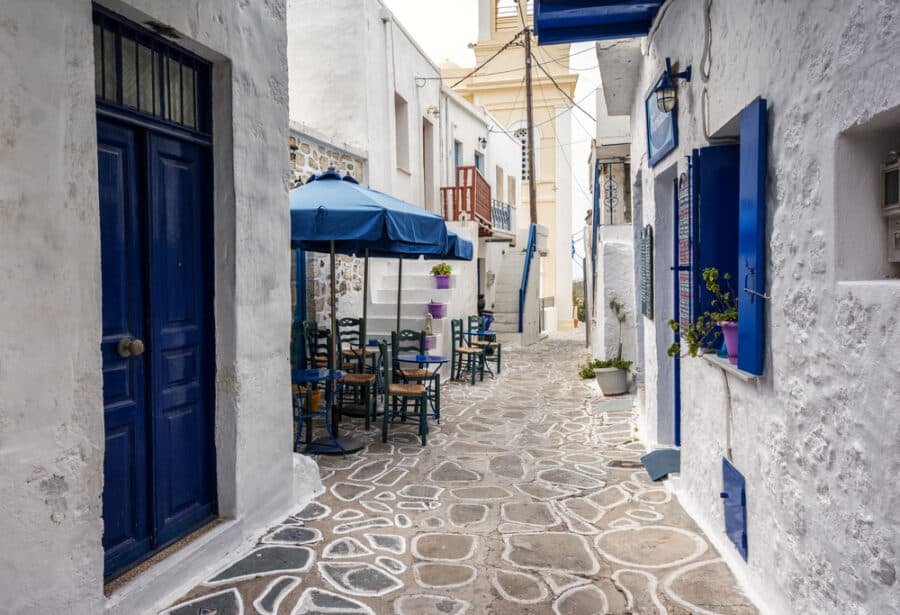
The island is not as big as you would expect, yet it is home to some unique beaches. Visiting them all will undoubtedly take most of your time. However, going to the beach is far from being the only thing to do in Kimolos. You can also enjoy sightseeing, hiking, and exploring its small but super charming main town. These are some of the top things you can do in Kimolos during your visit.
Kimolos’s Main Settlement: Chorio
Chorio is the most important town on the island and is incredibly charming. The small but highly picturesque town is a perfect concentration of Cycladic architecture. In Kimolos’ Chorio, you will find traditional cobble-stoned winding alleys, colorful and narrow, dotted with cubic whitewashed homes with typical blue shutters and wooden doors, small balconies or patios facing the streets, and plenty of pots and flowers.
In the village, you can taste delicious food in the local restaurants, fish taverns, and authentic cafés (locally called kafenia), but you can also check out small blue-domed chapels and buy local souvenirs in the many small shops.
There are also other small settlements on Kimolos that you can visit, but they are small and have just a few inhabitants. Some of them are Psathi, Prassa, Alyki, Bonatsa, Poliegos, and Groupa.
Check The Kastro (Castle)
Arguably, one of the most attractive places you can visit in Chorio is the area of the Kastro. As you probably already know from our extensive selection of guides to the Greek Islands, Kastro translates to the castle, and the same as many of these islands, there is always a castle to visit, often of Venetian origin, from the times when most of the islands were ruled by the Republic of Venice.
Greek castles were built to protect against common pirate raids and sea attacks (mainly from the Ottoman Empire). Particularly in Kimolos, the area of the Kastro is made of two different tiny neighborhoods, Mesa Kastro and Exo Kastro, which literally mean “in the middle of the Castle” and “outside the castle.
Houses were built and inhabited inside the castle’s walls until the end of the nineteenth century, when buildings started to expand outside its walls, thus creating two different neighborhoods. Arched doors connect both areas.
While inside the castle walls, you can see the oldest church in Kimlos, from 1592, known as the Church Birth of Jesus.
Visit The Folklore And Maritime Museum Of Kimolos
You cannot visit a Greek Island without making at least a quick stop at its folk museum. In Kimolos, the museum is inside a traditional Venetian Mansion in the area of Mesa Kastro, in Chorio. The museum focuses on the island’s local traditions and historical lifestyle, exhibiting local tools used for daily tasks and occupations, including fishing, mining, and agriculture.
In the museum, you can also check out traditional costumes, unique handmade fabrics and garments, kitchen pottery, and elements related to marine activities as well.
Explore The Archaeological Museum Of Kimolos
The next museum you can visit in Kimolos is the Archaeological Museum, also located in Chorio. You will find this exhibition in one of the oldest houses in the area of Exo Kastro, outside the Venetian Castle’s walls.
The two-story building, an ancient mansion from the nineteenth century, features findings excavated around the island dating back to prehistoric times. The small but pleasant exhibition presents the collections in an orderly and chronological manner, making it easier for visitors to understand the historical evolution of the island.
Clay and pottery objects, figurines, and funerary relics are among the most impressive artifacts. The museum also features an interesting multimedia area, photos, and other documents depicting interesting traits of the local history.
Pay A Visit To Panagia Odigitria Cathedral
Another place you don’t want to miss in town is Panagia Odigitria, the main church in Kimolos, right across from the Archaeological Museum. Dedicated to the Blessed Virgin Mary, the island’s patron, this imposing church was built between 1867 and 1874 and houses ancient and significant icons. The most remarkable of them, the icon of the Panagia Odigitria, dates back to the fifteenth century, and its origin is uncertain.
Watch An Outdoor Movie
An open-air, portable cinema called Cine Kalisperitis shows movies during the summer season, either in the castle or at any number of beaches on Kimolos. Lanterns and torches light the walkways, romanticizing and charming the effect.
While in Chorio, you will see posters around town with information about the various movie showings and locations.
Spend A Few Hours In Goupa
Located towards the eastern area of Chorio, Goupa is a small and uniquely picturesque fishermen’s settlement that you can also visit. In the area, you will discover the curious sirmata.
Sirmata are small caves that have been carved in the rock and that have been used for hundreds of years to shelter fishing boats during wintertime. These unique caves are also used as houses in the hot season.
While in the area, check out Elephant Rocks, which looks just like its name suggests. From here, a rocky beach with soft white rocks is an excellent spot to do a bit of snorkeling.
Explore Psētopōleío
Everyone knows how beautiful Greek villages are; with their whitewashed houses and stunning architecture, they might be some of the loveliest places in the world. In this sense, Psetopoleio doesn’t offer you anything new. It’s a beautiful Greek village with many houses, clean streets, and tasty food. However, it is famous for being the only village located on a hilltop on Kimolos Island. Therefore, if you want to take great pictures for your social media accounts, Psetopoleio is the way to go!
Church Of Saint Methodia
One of the places you should also visit inside the Kastro is this tiny church dedicated to Saint Methodia. The saint was born on the island back in 1861. According to the legend, Saint Methodia had been married to a local fisherman who drowned at a shipwreck.
At that time, she became a nun and lived inside the castle in a small, simple room next to the ancient church of the Birth of Christ. She was made a saint about ninety years after her death, and afterward, her room was transformed into a small chapel.
Marvel At The Natural And Mineral Landscape
Like its neighboring island, Milos, Kimolos, and other smaller islands around them are part of the so-called Aegean Volcanic Arc, featuring acidic volcanic rocks. The constant volcanic activity is visible in the many hot springs in different areas and the unique and often bizarre rock formations.
The island is rich in tuff — locally known as poria; this common volcanic rock has often been used in construction due to its excellent insulating qualities and because it is also a light material. The poria had long represented an important revenue for the islanders as it was the most important product of the island and was also commerced in many areas of the Mediterranean.
Another unusual element you will abundantly find on the island is a kind of clear clay known as Kimolia Gee. Due to its unique chemical composition (and since it is only found in Kimolos), this mineral element has one-of-a-kind detergent and pharmaceutical properties, and it was another valuable product exported by locals.
The island also boasts a huge variety of Mediterranean species (about 400), including hundreds of medicinal plants and aromatic herbs used in gastronomy and by the pharmaceutic industry.
Species such as capers, thyme, myrtle, sand lilies, and cedar trees easily grow on the island alongside traditional species such as figs, olives, and grapes. Although these may sound common on other Cycladic islands, they are not expected on a dry island like Kimolos.
Take A Snapshot At Skiadi

When it comes to unusual landscapes, there’s no clearer example on the island than the Skiadi. This impressive stone formation looks like a mushroom or umbrella, located in the heart of a valley and eroded by the constant winds in the area.
The curious rock features a base made of a kind of material much softer than its top. The stone has been included in the Atlas of Geological Monuments of the Aegean, and it is one more landmark in Kimolos that should not be missed. Open Lending Library Of Kimolos
You’ll find an outdoor library in four different parts of the island, and volunteers run the whole thing. If you want to help, you can leave a book for other people to take, and there are no booking in or out procedures here; you see a book you like and take it. It’s a great way to learn more about the local area, as many of the books are about the island itself.
Check Out The Kimolos Windmills
The island is home to 7 windmills, traditional and lovely to view. If you head to Tsoukalas, you can hike towards Chorio, and along the way, you will find the windmills.
Hiking In Kimolos
Like many other islands in Greece, walking, hiking, and trekking are some of the most popular activities. The island features some interesting hiking trails, which represent a top opportunity to see the best areas of Kimolos and will take you along lesser-known spots around the island, some of which are not accessible by car.
Seven trails on the island are signposted and are easy paths for hikers of all abilities to travel.
Snorkel The Sunken City
If you head to Mavrospilia Beach, head out to snorkel the ancient, sunken city of Ellinika and its necropolis. The beach itself is also scattered with tombs from ancient times.
Coordinate Location: (36 degrees, 47’16” N 24 degrees, 31’49” E)
Explore Kimolos Caves
Pelekiti Cave in Kakopotamos is accessible by water, so you must take a boat to reach it. Once there, jump into the water and enter the cave. Wade through the shallow waters inside to fully explore the cave.
Another cave worth exploring on the island is Konsolinas in Paleokastro. The one-room cave is located on Paleokastro Peak, which can be reached by foot. The hike to get to the cave will also take you past the ancient remains of a castle.
Take A Trip To Polyaigos Island
This wild island is home to 2 residents, so you can imagine just how untouched nature is here! Volcanic rocks, caves, crystal waters, corals, shells, and native species await you to discover.
While visiting, be sure to kayak to the famous rock formations in the middle of the sea known as Kalogeri and check out the stunning Fanara Cave, with large holes in its roof, allowing sunlight to stream in and dance on the turquoise waters.
Brands We Use And Trust
Best Beaches Of Kimolos
It would be a pity to visit the Greek Islands and not visit at least some of the stunning beaches. This is also true in Kimolos, where you won’t only find several incredible beaches, but you will be happy to know that many are often very quiet and allow you to spend a day in total solitude.
Kimolos boasts some incredible unspoiled shores that you shouldn’t miss.
Although some of these beaches can be reached by the local bus, renting a car to reach less-visited shores is always better.
Psathi Beach
Psathi Beach is probably the most important and popular beach on Kimolos. It is a small, sandy shore close to the port and features some basic organization, including sunbeds and umbrellas. The beach is close to the island’s center, making it easy to access.
Soufli Beach
A serene stretch of sand nestled along the turquoise waters of the Aegean Sea, Soufli Beach offers you tranquillity and peace. Secluded from the outer world by the verdant hills surrounding the beach, Soufli is a paradise where nobody can interrupt you. Despite being a small beach, as there aren’t often many people on the island, Soufli offers you a break from the crowds and being all alone.
Aliki Beach
Aliki Beach is a long beach that mixes sand and pebbles, while a few trees offer natural shade. In the area, you can check a unique salt pan where you’ll be able to spot unique bird species.
Athinia Beach
The picturesque Athinia Beach is one of the best beaches in Kimolos. Like other beaches on the island, hills, olive groves, and fragrant herbs surround the lengthy beach. Athinia offers a breathtaking sea view with crystal clear water stretching out to the horizon. This peaceful, serene spot gives a sense of escape from the hustle and bustle of daily life.
Bonatsa
Bonatsa is another tranquil beach that we recommend you check on Kimolos. It is a popular beach for families with children as it features calm, shallow waters, natural shade, and a few structures in the area for a day out, such as tavernas and snack bars for refreshments.
Dekas Beach
Another shore that’s also good for families is Dekas Beach. The tranquil, long beach features soft sand and crystal-clear waters, and it can only be accessed by a dirt road. Probably, the lack of easy access is what makes it a top place for naturism and free camping.
Prassa Beach
Those who go to popular places should spend at least a day on Passa Beach. The picturesque shore is shallow and kid-friendly, well-organized, and often full of visitors.
Mavrospilia
If you’re looking for a scenic beach, head to Mavrospilia, a fantastic sandy beach shore with unique white rock formations.
A long and picturesque beach that is only accessible by following a winding track road, Mavrospilia is a hidden gem. Its crystal-clear water and shoreline sprinkled with vegetation make it a perfect spot for swimming and soaking up the sun. Since Mavrospilia rarely has tourists or locals, it is truly a hidden gem where one can escape the stresses of daily life and immerse oneself in the natural beauty of the Greek islands.
Klima Beach
The Klima beach was a popular spot for tourists and locals alike due to its closeness to Chorio, lively atmosphere, and variety of beach activities. Although there’s vegetation around the beach, it is not widespread, and the beach doesn’t feature any umbrellas or sun lounges, so you’ll need to bring your umbrella. Besides this, the spot is perfect for water sports, such as snorkeling and paddleboarding. Since there is a settlement nearby, you will have the opportunity to taste the local food; this makes Klima excellent for tourists as it’s within a short walk of a few minutes from most hotels on the island.
Ellinika Beach
Are you ready for an adventure? Because Ellinika Beach offers one! Located near an ancient city, Ellinika Beach is a place of history and culture. With remarkable rock formations on the sea and the majestic view from the beach, you can spend your evening on Ellinika Beach and watch the sun set over the turquoise waters of the Aegean Sea. The long beach also allows you to stroll up and down the shore while drinking your cocktail and have a peaceful time away from mundane everyday life.
Monastiria
Located in the northern part of the island, the gorgeous beach of Monastiria is another must-visit place when discovering the island. It is accessed by driving along a dirt road up to one point, but then it is necessary to hike for a while to get there.
Surrounded by unique rocks, the beach is tranquil and unspoiled. Not far from the shore, about a 30-minute walk away, you will find Soufli, another bay with plenty of shade trees that is also popular for camping and naturism.
Prasa Beach
Prasa Beach is a beautiful spot a short distance away from Chorio. The waters are extremely clear, and the sand is clear white. This is an excellent spot for families, and there are lots of facilities on site, including sun loungers, parasols, and a small cafe for refreshments. The trees and cliffs around the beach also provide plenty of shade. You do have to walk down to the beach along a path, but it’s not that uneven or difficult, so as long as you take your time, you should be fine.
Therma Beach
Therma Beach is somewhat of a hidden gem. You can only get to it by boat, but it’s well worth the effort. The huge cliffs drop right down to this tiny crescent beach, and the waters are crystal clear. However, don’t be tempted to touch the water that gushes out through the holes in the rocks, as this is thermal water, which is actually slowly melting the rocks! The temperature of the water can get extremely hot, so just observe it without touching it.
Where To Eat In Kimolos

Avli Tou Samplou
In the main square of Chorio, Avli tou Samplou is a popular tavern set in a picturesque garden serving traditional Kimolian and Greek food at affordable prices and suitable for the whole family.
To Raventi
Are you craving some unique Greek sweets? Then head to To Raventi in Psathi, near the port and the beach. Here, you can enjoy some unique pancakes and the traditional Greek galaktoboureko cake with creamy, vanilla-flavored custard and tons of delicate honey syrup.
Agora Cocktail Bar
For a drink and a chilling moment in the Kastro, choose a table at Agora Cocktail Bar and enjoy friendly service, a great selection of cocktails, incredible music, and a friendly atmosphere.
Where To Stay In Kimolos
Although the island has yet to see a tourist invasion (hopefully it won’t), a few interesting hotels cater to all travelers and for every budget. Most of them are simple but hospitable and welcoming. These are the ones I recommend:
Picturesque Stays In Kimolos
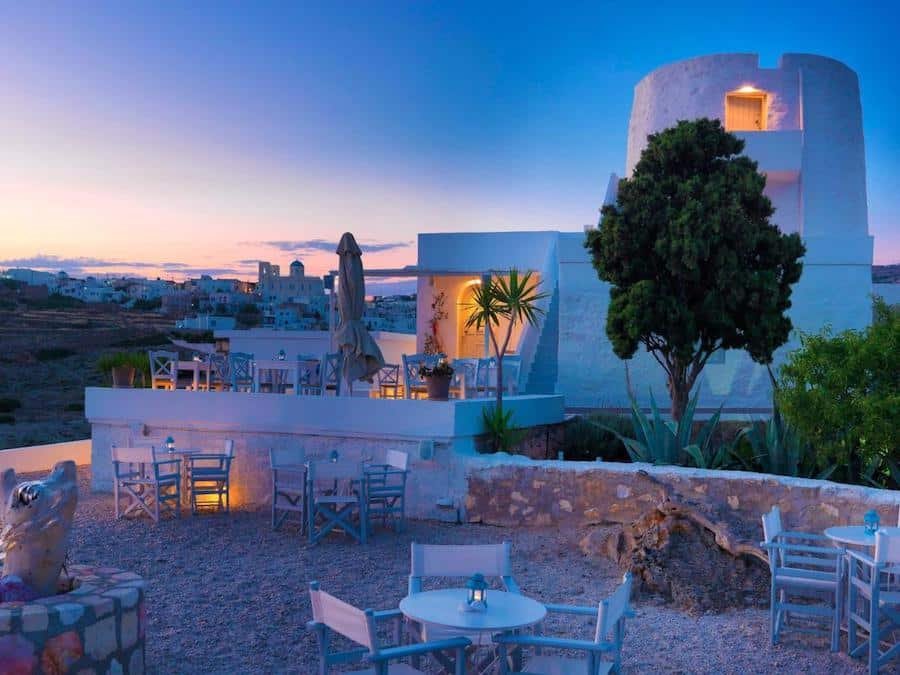
Windmill Kimolos is an original property located only 5 minutes from the beach, about 500 meters from the port of Psathi. The accommodation is set in a nineteenth-century traditional windmill that has been restored. It features a bar and a terrace with terrific sea views. The elegant units open either to a balcony or a patio and include comfy beds and built-in sofas. The property offers a daily English breakfast at the sea-view sun terrace, while drinks and light snacks are available all day at the on-site bar. The property is located 1 km from Chorio, while Aliki Beach is 3 km away.
Family Stays In Kimolos
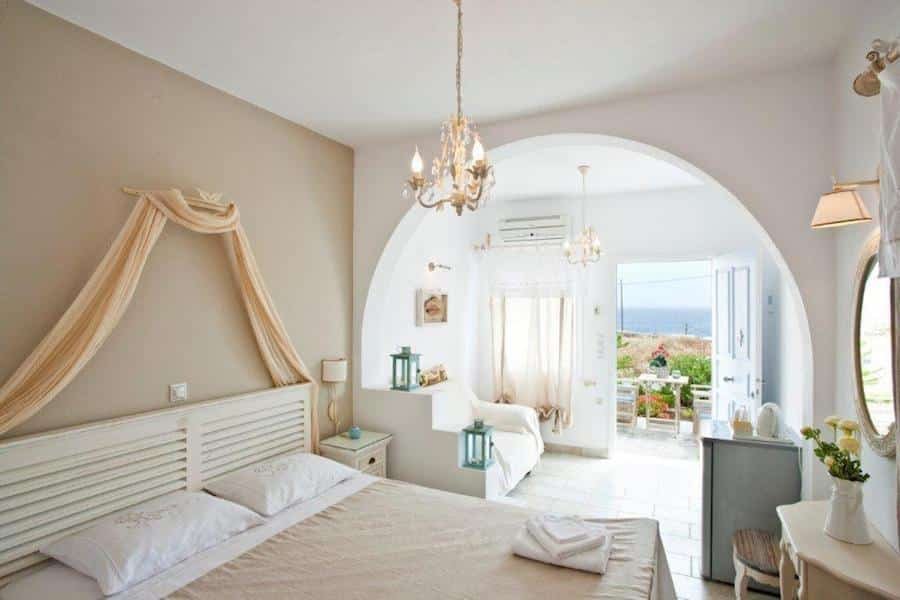
Kimolis is a Cycladic-style accommodation located about 250 meters from Psathi Beach, offering balconies with stunning views of the Aegean Sea. Some units feature a fully equipped kitchen with a dining area. The home is just a short distance from Chorio and the main port of Kimolos.
Elzahed Apartments on Kimolos are located in a charming Greek town with several taverns and restaurants serving delicious local cuisine. With its magnificent amenities and excellent facilities, Elzahed Apartments are some of the best choices for a quality hotel where you can immerse yourself in the local culture.
Homey Stays In Kimolos
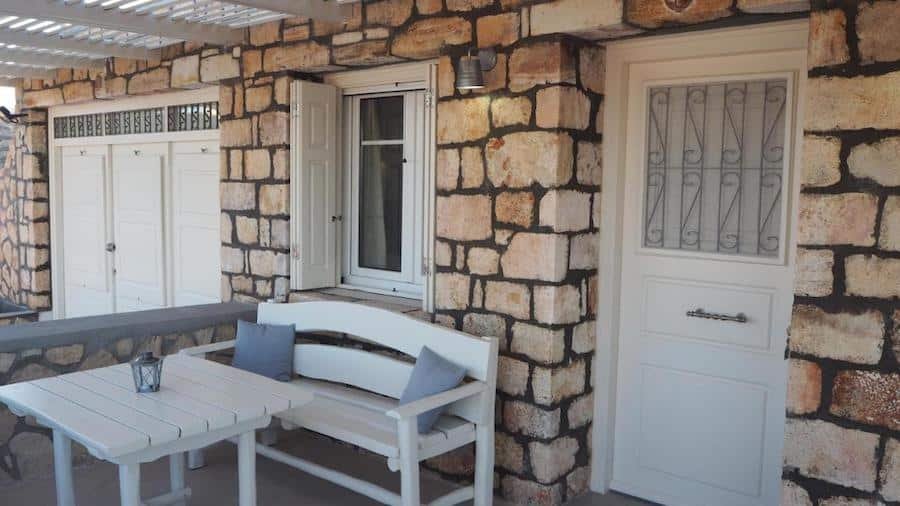
Ataraxia- Stonebuilt Studios and Apartments is a perfect alternative if you want to enjoy the comfort of a villa or even a tiny apartment on the island. The property boasts impeccable online reviews, is just a 5-minute walk from the beach, and has a beautiful and relaxing garden. The apartments are close to Klima Beach.
Themonia Studios is a comfy place to stay in Kimolos. Themonia is a private hotel where you will feel at home, thanks to its friendly owners and high-quality facilities. Located on a quiet street in the heart of the island, Themonia is surrounded by lush gardens and a stunning view of the crystal-clear waters of the Aegean Sea.
Move This Adventure To Your Inbox & Get An Instant Freebie

No spam. Unsubscribe at any time.
How To Get To Kimolos
You can only travel to Kimolos via sea, so you must take a ferry from Athens or the nearby island of Milos if you’re island-hopping in Greece.
If you’re departing from Athens, ferries leave from the port of Piraeus. The ferry frequency in summer is higher than during the rest of the year, with one daily boat departing from Athens. The trip can take between 3 and 6 hours, depending on the type of vessel (regular or fast ferry). Since Kimolos is not as visited as other Greek islands, you won’t need to purchase the tickets months in advance; just a few days before the trip will often be enough.
Visiting from Milos is easy, whether Kimolos is part of your island itinerary or on a day trip. The islands are connected by a local ferry that runs between both destinations at least four times daily (this can even double during summer). This ferry has a cheaper ticket fee but is quickly canceled in bad weather conditions. If you’re traveling in autumn, it might be better to travel with a conventional ferry. The crossing from Milos to Kimolos takes about half an hour with the small ferry, while conventional ferries take longer.
Best Time To Visit Kimolos
As with most of the Cycladic islands, the best time of the year to visit is the months between May and September. The weather starts to warm up as early as the end of April, and it can remain pleasant as long as October.
The central months of this period, July and August, are often the hottest months in Greece and the ones when you’ll see more crowds almost in every destination.
Since Kimolos is quite off-the-beaten-path, the island won’t be as crowded; however, you’ll indeed find dozens of tourists coming from Milos for the day.
When is the best time to visit Kimolos Island?
May- September is the optimal time as tourist accommodations and restaurants are open and in full swing. Things are much quieter in the winter.
How do I get to Kimolos?
There is no airport, so you’ll need to take a ferry. The best routes are from Milos, which is only a 20-minute ride, or directly from Athens, which is a 5-6 hour ride. Other Cycladic islands can also be reached via ferry, but not quite as regularly.
What is the closest airport to Kimolos?
Milos Airport
Is Kimolos a safe island to visit?
In terms of crime, it’s a very safe island. However, if you plan to hike and do lots of outdoor exploring, be aware that venomous vipers inhabit the island. Keep a watchful eye and leave snakes alone should you come across them.
How many days are needed to explore Kimolos?
You can easily drive the island in a day if you are taking a day trip from Milos; however, there’s plenty to explore, so spending a whole week here would not be out of the question!

